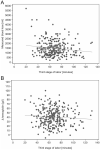Retained placenta and postpartum hemorrhage: time is not everything
- PMID: 33743043
- PMCID: PMC8429398
- DOI: 10.1007/s00404-021-06027-5
Retained placenta and postpartum hemorrhage: time is not everything
Abstract
Purpose: Postpartum hemorrhage is the major cause of maternal mortality worldwide. Retained placenta accounts for nearly 20% of severe cases. We investigated the influence of the time factor and retained placenta etiology on postpartum hemorrhage dynamics.
Methods: Our retrospective study analyzed a single-center cohort of 296 women with retained placenta. Blood loss was measured using a validated and accurate technique based on calibrated blood collection bags, backed by the post- vs pre-partum decrease in hemoglobin. We evaluated the relationship between these two blood loss parameters and the duration of the third stage of labor using Spearman rank correlation, followed by subgroup analysis stratified by third stage duration and retained placenta etiology.
Results: Correlation analysis revealed no association between third stage duration and measured blood loss or decrease in hemoglobin. A shorter third stage (< 60 min) was associated with significantly increased uterine atony (p = 0.001) and need for blood transfusion (p = 0.006). Uterine atony was significantly associated with greater decrease in hemoglobin (p < 0.001), higher measured blood loss (p < 0.001), postpartum hemorrhage (p = 0.048), and need for blood transfusion (p < 0.001).
Conclusion: Postpartum blood loss does not correlate with third stage duration in women with retained placenta. Our results suggest that there is neither a safe time window preceding postpartum hemorrhage, nor justification for an early cut-off for manual removal of the placenta. The prompt detection of uterine atony and immediate prerequisites for manual removal of the placenta are key factors in the management of postpartum hemorrhage.
Keywords: Manual removal of the placenta; Postpartum hemorrhage; Retained placenta; Third stage of labor; Uterine atony.
© 2021. The Author(s).
Conflict of interest statement
The authors declare that they have no conflict of interest.
Figures


Similar articles
-
The increasing role of a retained placenta in postpartum blood loss: a cohort study.Arch Gynecol Obstet. 2019 Mar;299(3):733-740. doi: 10.1007/s00404-019-05066-3. Epub 2019 Feb 7. Arch Gynecol Obstet. 2019. PMID: 30730011
-
Aetiology and treatment of severe postpartum haemorrhage.Dan Med J. 2018 Mar;65(3):B5444. Dan Med J. 2018. PMID: 29510809 Review.
-
Placental cord drainage and its outcomes at third stage of labor: a randomized controlled trial.BMC Pregnancy Childbirth. 2022 Jul 18;22(1):570. doi: 10.1186/s12884-022-04877-8. BMC Pregnancy Childbirth. 2022. PMID: 35850666 Free PMC article. Clinical Trial.
-
Placental cord drainage and the effect on the duration of third stage labour, a randomized controlled trial.J Med Assoc Thai. 2009 Apr;92(4):457-60. J Med Assoc Thai. 2009. PMID: 19374293 Clinical Trial.
-
Time to redefine prolonged third stage of labor? A systematic review and meta-analysis of the length of the third stage of labor and adverse maternal outcome after vaginal birth.Am J Obstet Gynecol. 2025 Jan;232(1):26-41.e11. doi: 10.1016/j.ajog.2024.07.019. Epub 2024 Jul 19. Am J Obstet Gynecol. 2025. PMID: 39032724
Cited by
-
Surgical Conservative Management of a Retained Placenta after Angular Pregnancy, a Case Report and Literature Review.Diagnostics (Basel). 2023 Nov 21;13(23):3492. doi: 10.3390/diagnostics13233492. Diagnostics (Basel). 2023. PMID: 38066733 Free PMC article.
-
Application of intraoperative abdominal aortic balloon occlusion for bleeding during cesarean section in pernicious placenta previa.Am J Transl Res. 2024 Sep 15;16(9):4939-4949. doi: 10.62347/JMWT8383. eCollection 2024. Am J Transl Res. 2024. PMID: 39398584 Free PMC article.
-
Ultrasound for diagnosis of postpartum retained products of conception-How accurate we are?BMC Pregnancy Childbirth. 2023 Aug 10;23(1):572. doi: 10.1186/s12884-023-05863-4. BMC Pregnancy Childbirth. 2023. PMID: 37563560 Free PMC article.
-
Development and validation of a nomogram for predicting postpartum hemorrhage in women with preeclampsia: A retrospective case-control study.Medicine (Baltimore). 2024 Nov 8;103(45):e40292. doi: 10.1097/MD.0000000000040292. Medicine (Baltimore). 2024. PMID: 39533638 Free PMC article.
-
Is it worth to insert uterine pack instead of Bakri balloon to control postpartum hemorrhage after vaginal delivery in hypertensive patients?Arch Gynecol Obstet. 2023 Apr;307(4):1195-1201. doi: 10.1007/s00404-022-06543-y. Epub 2022 Apr 9. Arch Gynecol Obstet. 2023. PMID: 35396973
References
Publication types
MeSH terms
LinkOut - more resources
Full Text Sources
Other Literature Sources

